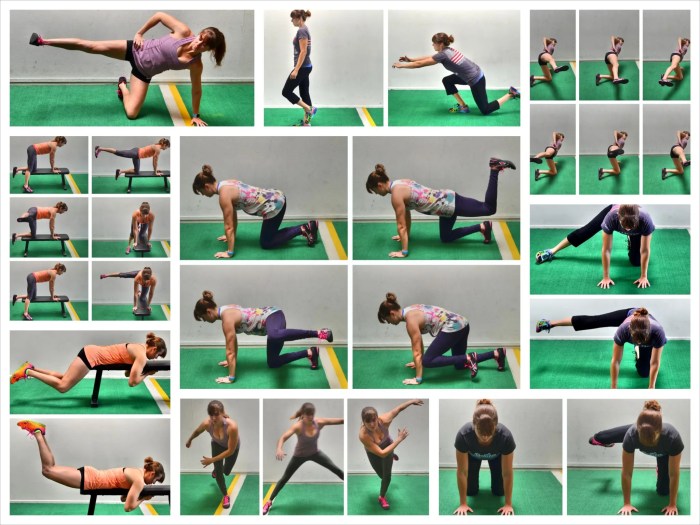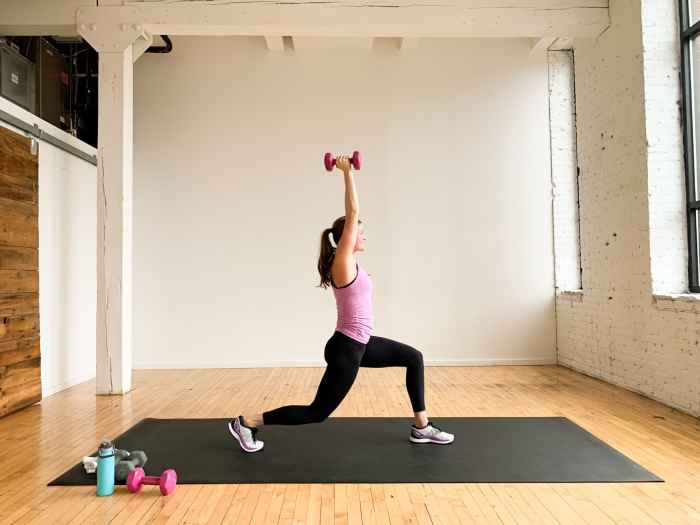Strength training workouts for women are not just about building muscles; they are about empowering women to take control of their health, fitness, and overall well-being. This guide will provide you with all the information you need to create a strength training program that is tailored to your individual needs and goals, helping you achieve your full potential and unlock a stronger, more confident you.
Strength training offers a multitude of benefits for women, including increased muscle mass, improved bone density, enhanced metabolism, reduced risk of chronic diseases, and improved mood and cognitive function. By engaging in regular strength training, women can not only improve their physical health but also boost their self-esteem and confidence levels.
Strength Training Benefits for Women
Strength training is an essential part of a healthy lifestyle for women of all ages. It can help improve overall health and well-being, and it has unique benefits for women specifically.
Some of the benefits of strength training for women include:
- Increased muscle mass and strength
- Improved bone density
- Reduced risk of osteoporosis
- Improved cardiovascular health
- Reduced risk of chronic diseases, such as heart disease and stroke
- Improved mood and reduced stress
- Increased energy levels
- Improved sleep quality
- Reduced risk of falls and injuries
Strength training can also help women lose weight and maintain a healthy weight. It can help boost metabolism, burn calories, and reduce body fat.
Some of the best strength training exercises for women include:
- Squats
- Lunges
- Push-ups
- Rows
- Deadlifts
- Overhead press
It is important to start slowly and gradually increase the weight and intensity of your workouts over time. It is also important to listen to your body and rest when you need to.
If you are new to strength training, it is a good idea to talk to a personal trainer or fitness professional to get started.
Safety Considerations for Women
There are a few safety considerations that women should keep in mind when engaging in strength training.
- Use proper form to avoid injury.
- Warm up before your workout and cool down afterwards.
- Listen to your body and rest when you need to.
- Avoid lifting too much weight.
- If you have any underlying health conditions, talk to your doctor before starting a strength training program.
Exercise Selection
Exercise selection is paramount for effective strength training workouts for women. It’s crucial to target multiple muscle groups to achieve balanced development and maximize results.
Beginners should focus on compound exercises that work for multiple muscle groups simultaneously, such as squats, lunges, push-ups, and rows.
Sample Exercise Plan
Beginner Plan
- Squats: 10-12 reps, 3 sets
- Lunges: 8-10 reps per leg, 3 sets
- Push-ups: As many reps as possible, 3 sets
- Rows: 10-12 reps, 3 sets
Advanced Plan
- Barbell squats: 8-10 reps, 4 sets
- Romanian deadlifts: 10-12 reps, 4 sets
- Dumbbell bench press: 10-12 reps, 4 sets
- Pull-ups: As many reps as possible, 4 sets
Proper Form and Technique
Proper form is crucial in strength training to prevent injuries and maximize results. Follow these guidelines to perform exercises correctly.
Each exercise has specific instructions to ensure proper execution. Pay attention to the details and avoid common mistakes.
Key Points for Each Exercise, Strength training workouts for women
| Exercise | Proper Form | Common Mistakes | Tips |
|---|---|---|---|
| Barbell Squat | – Stand with feet shoulder-width apart, toes slightly turned out.
|
– Squatting too deep (below parallel).
|
– Keep your chest up and your core engaged.
|
| Bench Press | – Lie on a bench with your feet flat on the floor.
|
– Arching your back.
|
– Keep your back flat against the bench.
|
| Deadlift | – Stand with your feet hip-width apart, toes slightly turned out.
|
– Rounding your back.
|
– Keep your back straight throughout the movement.
|
Frequency and Duration
Determining the optimal frequency and duration of strength training workouts for women depends on several factors, including fitness level, goals, and lifestyle. It’s essential to find a balance that allows for progress without overexertion or burnout.
The concept of progressive overload is crucial in strength training. This involves gradually increasing the intensity or load over time to challenge the muscles and promote growth. Examples include increasing the weight lifted, sets, repetitions, or reducing rest time.
Balancing Strength Training with Other Activities
Balancing strength training with other fitness activities, such as cardio and flexibility exercises, is important for overall fitness. Aim to incorporate a variety of activities into your routine to target different aspects of your health and well-being.
Recommended Frequency, Duration, and Intensity
The following table provides general recommendations for strength training frequency, duration, and intensity based on fitness level:
| Fitness Level | Frequency | Duration | Intensity |
|---|---|---|---|
| Beginner | 2-3 days per week | 20-30 minutes per session | 60-70% of 1RM |
| Intermediate | 3-4 days per week | 30-45 minutes per session | 70-80% of 1RM |
| Advanced | 4-5 days per week | 45-60 minutes per session | 80-90% of 1RM |
Note: 1RM refers to the maximum weight that can be lifted for one repetition.
Nutrition for Strength Training

Optimizing nutrition is crucial for maximizing strength training outcomes. It provides the necessary building blocks for muscle growth, recovery, and performance.
Understanding the role of macronutrients, hydration, and overall dietary principles will help you fuel your body effectively for strength training goals.
Protein Intake
Protein is essential for building and repairing muscle tissue. Aim for 1.6-2.2 grams of protein per kilogram of body weight daily. Good protein sources include lean meats, poultry, fish, eggs, dairy products, and plant-based proteins like beans and lentils.
Hydration
Staying hydrated is vital for overall health and performance. Drink plenty of water throughout the day, especially before, during, and after workouts.
Overall Dietary Considerations
Focus on consuming a balanced diet rich in whole, unprocessed foods. Include plenty of fruits, vegetables, whole grains, and healthy fats. Limit processed foods, sugary drinks, and unhealthy fats.
Fueling Before and After Workouts
Consume a meal or snack rich in carbohydrates and protein 1-2 hours before a workout. After a workout, refuel with a similar meal or snack within 30-60 minutes to aid recovery.
Nutrient Requirements for Different Phases
During bulking (gaining muscle mass), increase calorie intake and protein consumption. During cutting (losing body fat), maintain a calorie deficit while prioritizing protein intake.
Sample Meal Plans
- Bulking:Oatmeal with berries and nuts for breakfast, chicken with brown rice and vegetables for lunch, salmon with roasted vegetables for dinner.
- Cutting:Greek yogurt with fruit for breakfast, tuna salad with whole-wheat crackers for lunch, grilled chicken with quinoa and broccoli for dinner.
– Warm-up

A dynamic warm-up prepares your body for the demands of strength training by increasing body temperature and activating muscles.
Incorporate exercises that mimic the movements involved in your workout, such as arm circles, leg swings, and jumping jacks.
– Dynamic Warm-up Routine
- Arm circles: 10-15 reps forward and backward
- Leg swings: 10-15 reps front and back
- Jumping jacks: 20-30 reps
- High knees: 20-30 reps
- Butt kicks: 20-30 reps
Variations for Different Fitness Levels
Tailoring strength training workouts to different fitness levels is crucial for maximizing results and minimizing the risk of injury. Here’s how to modify exercises and adjust intensity for beginners, intermediates, and advanced individuals:
Beginners
- Focus on compound exercises:Engage multiple muscle groups simultaneously, such as squats, lunges, push-ups, and rows.
- Choose bodyweight exercises or light weights:Start with exercises that don’t put excessive strain on your body.
- Keep reps low (8-12) and sets moderate (2-3):Gradually increase weight or resistance as you progress.
- Rest adequately between sets (1-2 minutes):Allow your muscles to recover and prevent fatigue.
Intermediates
- Add isolation exercises:Target specific muscle groups, such as bicep curls, tricep extensions, and calf raises.
- Increase weight or resistance:Challenge your muscles to promote growth and strength gains.
- Increase reps (10-15) and sets (3-4):Gradually increase volume to stimulate muscle hypertrophy.
- Shorten rest periods (30-60 seconds):Improve endurance and increase metabolic demand.
Advanced
- Incorporate advanced techniques:Use supersets, drop sets, or rest-pause to intensify workouts.
- Lift heavy weights:Push your limits while maintaining proper form.
- Increase volume (reps and sets):Aim for high-volume workouts to maximize muscle growth and strength.
- Reduce rest periods (15-30 seconds):Enhance muscular endurance and cardiovascular capacity.
Home vs. Gym Workouts

Deciding whether to strength train at home or in a gym depends on your individual preferences, fitness goals, and lifestyle. Both options offer unique advantages and disadvantages.
Advantages of Home Workouts
- Convenience: You can work out whenever you want, without having to travel to a gym.
- Privacy: You don’t have to share equipment or worry about being judged by others.
- Cost-effective: You can save money on gym memberships and personal training.
Disadvantages of Home Workouts
- Limited equipment: You may not have access to all the equipment you need for a comprehensive workout.
- Lack of motivation: It can be harder to stay motivated when working out alone.
- Safety concerns: You need to ensure you have a safe and supportive workout environment.
Advantages of Gym Workouts
- Wide range of equipment: Gyms offer a variety of equipment to accommodate different fitness levels and goals.
- Professional guidance: Personal trainers can provide personalized instruction and support.
- Social atmosphere: Gyms offer a sense of community and motivation.
Disadvantages of Gym Workouts
- Cost: Gym memberships can be expensive.
- Travel time: You need to factor in the time it takes to travel to and from the gym.
- Crowds: Gyms can be crowded, especially during peak hours.
Creating an Effective Home Gym
If you choose to work out at home, it’s essential to create an effective home gym. Consider the following:
- Space: You need enough space to perform exercises safely and comfortably.
- Equipment: Choose essential equipment like dumbbells, resistance bands, and a weight bench.
- Safety: Ensure your workout area is well-lit, has a non-slip floor, and is free from obstacles.
Staying Motivated with Home Workouts
Staying motivated with home workouts can be challenging. Here are some tips:
- Set realistic goals: Don’t try to do too much too soon.
- Find a workout buddy: Having someone to work out with can help you stay accountable.
- Make it fun: Choose exercises you enjoy and vary your workouts to avoid boredom.
Motivation and Mindset
Strength training is not just about building physical strength; it also offers a wealth of psychological benefits for women. Engaging in strength training can boost self-confidence, reduce stress and anxiety, improve mood, and enhance cognitive function.
To stay motivated and overcome challenges, it’s essential to set realistic goals, focus on progress rather than perfection, and find an activity you enjoy. Embrace the journey and celebrate your achievements along the way.
Building a Positive Mindset
- Challenge negative self-talk and replace it with positive affirmations.
- Surround yourself with supportive people who encourage your fitness goals.
- Visualize yourself achieving your goals to stay inspired.
Case Studies and Success Stories
Witness the remarkable journeys of women who have transformed their lives through strength training. These inspiring stories highlight the challenges they overcame, the dedication they exhibited, and the incredible results they achieved.
Overcoming Obstacles
- Maria’s Story:Maria, a single mother of two, struggled with low self-esteem and a sedentary lifestyle. Strength training empowered her to gain confidence, lose weight, and improve her overall health.
- Sarah’s Journey:Sarah, a professional athlete, faced a career-ending injury. Through strength training, she rebuilt her strength, regained mobility, and returned to her sport stronger than ever before.
Testimonials and Transformations
“Strength training has given me a new lease on life. I feel stronger, healthier, and more confident than I ever have before.”
Maria
Before-and-after transformations showcase the transformative power of strength training. Women who once struggled with weight gain, low energy, and poor body image now exude vitality, strength, and a newfound sense of empowerment.
Inspiring Others
These success stories inspire countless women to embark on their own strength training journeys. They demonstrate that regardless of age, fitness level, or past experiences, anyone can achieve remarkable results through dedication and perseverance.
Concluding Remarks: Strength Training Workouts For Women

Embark on this strength training journey and witness the transformative power it holds. With dedication and consistency, you will not only build physical strength but also cultivate a mindset of resilience and empowerment. Embrace the challenges, celebrate your progress, and let strength training be the catalyst for your personal growth and transformation.
Questions and Answers
What are the key benefits of strength training for women?
Strength training helps women build muscle mass, improve bone density, enhance metabolism, reduce the risk of chronic diseases, and boost mood and cognitive function.
How often should women strength train?
Women should aim to strength train 2-3 times per week, targeting different muscle groups each session.
What exercises are best for women’s strength training?
Effective exercises for women’s strength training include squats, lunges, push-ups, rows, and bicep curls.
How can women stay motivated to strength train?
Set realistic goals, find a workout buddy, track your progress, and reward yourself for your effort.
Leave a Reply